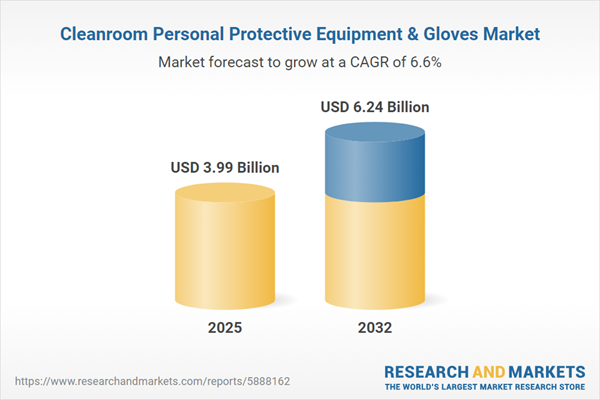Speak directly to the analyst to clarify any post sales queries you may have.
The cleanroom personal protective equipment and gloves market is experiencing significant transformation as advanced industries elevate contamination control requirements and place sustained emphasis on innovation, regulatory compliance, and supply chain resilience.
Market Snapshot: Cleanroom Personal Protective Equipment & Gloves Market Growth
The Cleanroom Personal Protective Equipment & Gloves Market grew from USD 3.74 billion in 2024 to USD 3.99 billion in 2025, and is projected to continue expanding at a CAGR of 6.58%, reaching USD 6.24 billion by 2032. Robust advancement is being driven by increased investment across biopharmaceutical, electronics, and healthcare sectors, each demanding precise contamination controls. As technology-intensive manufacturing and research expand, the market for cleanroom PPE and gloves positions itself as a backbone of operational reliability and regulatory adherence.
Scope & Segmentation of the Cleanroom PPE & Gloves Market
This comprehensive research covers the evolving ecosystem of cleanroom PPE and glove solutions across applications, end-users, and supply chains. The study analyzes advancements in materials, integration of digital technologies, and sustainable sourcing practices. Segmentation includes:
- Product Categories: Caps & helmets, coveralls, face masks, hoods, overboots, latex gloves, neoprene gloves, nitrile gloves, polyisoprene gloves
- End-User Industries: Biologics manufacturing, electronics and semiconductor, healthcare facilities, medical device manufacturing, pharmaceutical manufacturing, stand-alone pharmacies
- Distribution Channels: Offline, online
- Geographic Regions: Americas—United States, Canada, Mexico, Brazil, Argentina, Chile, Colombia, Peru; Europe, Middle East & Africa—United Kingdom, Germany, France, Russia, Italy, Spain, Netherlands, Sweden, Poland, Switzerland, United Arab Emirates, Saudi Arabia, Qatar, Turkey, Israel, South Africa, Nigeria, Egypt, Kenya; Asia-Pacific—China, India, Japan, Australia, South Korea, Indonesia, Thailand, Malaysia, Singapore, Taiwan
- Technological Innovations: Smart textiles, real-time monitoring, antimicrobial and antistatic fabrics, circular economy initiatives
Key Takeaways for Senior Decision-Makers
- Material breakthroughs are altering the performance baseline, enabling higher protection and wearer comfort, while facilitating compliance with strict regulatory mandates.
- Digital capabilities are entering the market, with smart textiles and integrated monitoring now enabling data-driven management of product usage and environmental exposure.
- Sustainability initiatives are influencing supplier selection, as buyers increasingly favour recycled, biodegradable substrates and traceable sourcing aligned with corporate sustainability agendas.
- Regional regulatory harmonization and local investment trends are fostering partnerships that address both compliance challenges and market expansion opportunities.
- Leading suppliers are establishing advanced research centres, investing in digital platforms, and implementing take-back schemes to achieve circular economy principles and operational agility.
- Strategic collaboration and targeted workforce training are emerging as key methods to ensure protocol adherence in complex, multi-country cleanroom environments.
Tariff Impact and Strategic Supply Chain Responses
Recent tariff adjustments in the United States, particularly in 2025, have prompted manufacturers to reevaluate procurement and production. To manage these new pressures, companies are increasing nearshore and domestic production, building local innovation hubs, and establishing dual sourcing partnerships. These shifts not only mitigate cost exposure but foster greater supply chain transparency and resilience—critical factors in maintaining competitive positioning under evolving trade environments.
Research Methodology & Data Sources
This report utilizes a robust multi-phase research approach, combining in-depth executive interviews with top manufacturers, distributors, and end-users, alongside secondary research from peer-reviewed publications, white papers, and regulatory documents. Expert panel discussions and data triangulation ensure that insights reflect industry realities and current best practices, delivering actionable intelligence for executive strategy formulation.
Why This Report Matters to Senior Leaders
- Gain actionable, segmented insights to inform procurement, operational risk management, and innovation investments within the cleanroom PPE segment.
- Benchmark against competitive strategies and anticipate regulatory and technological shifts influencing future supply chain and compliance models.
- Leverage detailed analysis for regional and application-specific decision-making, supporting market expansion or optimization goals.
Conclusion
The cleanroom personal protective equipment and gloves sector is defined by responsive innovation, strategic compliance, and agile supply chains. Decision-makers equipped with these insights can position their organizations to capture emerging opportunities and drive long-term value across highly regulated industries.
Additional Product Information:
- Purchase of this report includes 1 year online access with quarterly updates.
- This report can be updated on request. Please contact our Customer Experience team using the Ask a Question widget on our website.
Table of Contents
3. Executive Summary
4. Market Overview
7. Cumulative Impact of Artificial Intelligence 2025
Companies Mentioned
The companies profiled in this Cleanroom Personal Protective Equipment & Gloves market report include:- Top Glove Corporation Berhad
- Ansell Limited
- Hartalega Holdings Berhad
- Kossan Rubber Industries Berhad
- Supermax Corporation Berhad
- Semperit AG Holding
- Sri Trang Agro-Industry Public Company Limited
- DuPont de Nemours, Inc.
- 3M Company
- Kimberly-Clark Corporation
Table Information
| Report Attribute | Details |
|---|---|
| No. of Pages | 195 |
| Published | October 2025 |
| Forecast Period | 2025 - 2032 |
| Estimated Market Value ( USD | $ 3.99 Billion |
| Forecasted Market Value ( USD | $ 6.24 Billion |
| Compound Annual Growth Rate | 6.5% |
| Regions Covered | Global |
| No. of Companies Mentioned | 10 |









